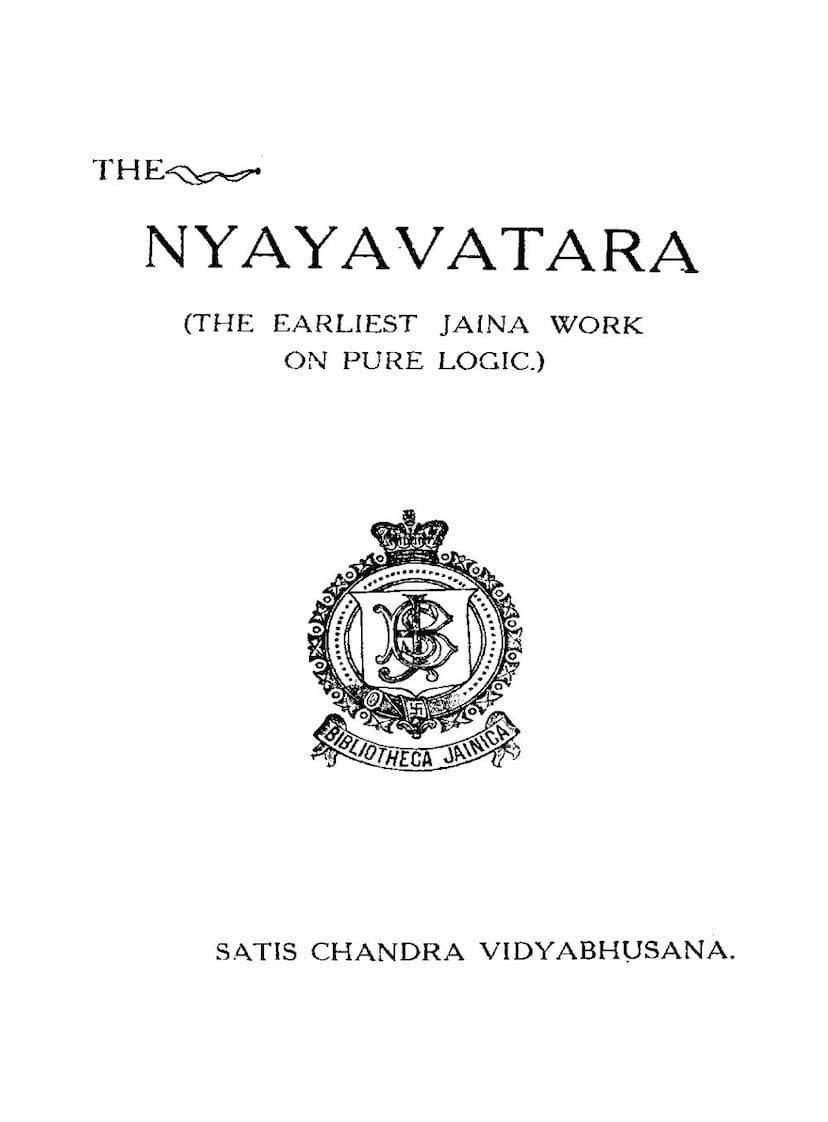Nyayavatara
Added to library: September 2, 2025

Summary
Here's a comprehensive summary of the Jain text Nyāyāvatāra based on the provided pages:
Book Title: Nyāyāvatāra (The Earliest Jaina Work on Pure Logic)
Author of the Edition: Mahamahopadhyaya Dr. Satish Chandra Vidyabhusana
Original Author: Siddha Sena Divakara (also known as Kṣapanaka)
Publisher: The Central Jaina Publishing House, Arrah (India)
Publication Date: 1915 (Second Edition)
Overall Summary:
The Nyāyāvatāra is a foundational Jain text that systematically lays out the principles of Jaina logic and epistemology. Authored by Siddha Sena Divakara, a significant figure believed to be a contemporary of King Vikramaditya, this work is considered the earliest known Jain treatise dedicated solely to pure logic. The edition by Satish Chandra Vidyabhusana aims to make this important philosophical work accessible with Sanskrit text, a detailed English translation, and explanatory notes derived from a commentary.
Key Concepts and Contributions:
-
Definition and Classification of Pramāṇa (Valid Knowledge):
- The text begins by defining Pramāṇa as knowledge that is self-luminous and capable of illuminating other things without obstruction. This definition is contrasted with Buddhist views (knowledge only self-luminous) and other Indian philosophical schools (knowledge only object-luminous).
- Pramāṇa is broadly classified into two types:
- Pratyakṣa (Direct Perception): Knowledge gained directly, not through the senses or other means. In older Jain texts, this could refer to perfect knowledge attained through meditation, but in this work, it refers to knowledge directly apprehended.
- Parokṣa (Indirect Knowledge): Knowledge acquired through the medium of senses or signs. This category includes Anumāna (inference) and Śabda (verbal testimony).
- The work emphasizes that knowledge must illuminate itself to be valid and to cognize external objects, likening it to a lamp.
-
Anumāna (Inference):
- Anumāna is defined as knowledge derived from a linga (mark or middle term) that is inseparably connected with the sādhya (major term or that which is to be proved).
- The text discusses both svārthānumāna (inference for oneself) and parārthānumāna (inference for others).
- Parārthānumāna is further elaborated upon, detailing its structure and importance. It emphasizes the need for explicit articulation of the pakṣa (minor term), hetu (middle term), and sādhya (major term).
- Various theories of inference from other schools (e.g., Buddhist logicians on grounds of inference like non-perception, identity, causality) are discussed and implicitly or explicitly rejected in favor of the Jain approach.
- The structure of a syllogism for parārthānumāna is outlined, including the five-membered form (proposition, reason, example, application, conclusion) and variations thereof.
- Crucially, the text details various fallacies of inference (hetvābhāsa):
- Pakṣabhāsa (Fallacy of the Minor Term): When the thesis is opposed by evidence, incapable of proof, or inconsistent with common understanding.
- Hetvābhāsa (Fallacy of the Middle Term): Including the asiddha (unproved), viruddha (contradictory), and anaikāntika (uncertain).
- Dṛṣṭāntābhāsa (Fallacy of the Example): Fallacies occurring in both homogeneous (sādharmya) and heterogeneous (vaidharmya) examples, arising from defects in the terms or their connection.
-
Śabda (Verbal Testimony):
- Śabda is defined as knowledge arising from words that express real objects consistent with perception.
- It is divided into laukika (from a reliable person) and śāstraja (from scripture).
- A scripture is defined as being invented by a competent person, not easily superseded, not contradictory to perception, imparting true instruction, and beneficial to all. This definition implicitly counters the Mimāmsā view of the eternality of the Veda.
-
Naya (Anekānta and Standpoints):
- A significant portion of the text delves into the Jain concept of Nayavāda (the doctrine of standpoints).
- It explains that objects have manifold characteristics (anekānta) and can be viewed from multiple perspectives.
- Naya refers to a particular viewpoint or method of understanding an object, focusing on one aspect while not denying others.
- Seven nayas are described:
- Naigama: Considering generic and specific aspects together.
- Saṃgraha: Focusing on generic properties.
- Vyavahāra: Focusing on practical, particular aspects.
- Ṛju-sūtra: Considering things as they are in the present moment, ignoring past or future.
- Śabda: Using words in their conventional sense.
- SāmAbhirūḍha: Making subtle distinctions among synonyms based on etymology.
- Evambhūta: Naming a thing only when it practically functions as such.
- The text then introduces Syādvāda, the doctrine of manifold predication, which harmonizes these various nayas and asserts that reality can be understood from seven possible standpoints (e.g., "may be it is," "may be it is not"). Syādvāda is presented as the knowledge that determines the complete meaning of an object by employing these one-sided nayas.
-
The Soul (Jiva):
- The soul (jiva) is described as the knower, doer, and enjoyer, which illuminates itself and others.
- It undergoes changes of condition (vivṛtimān), is realized through self-consciousness, and is distinct from inanimate matter (earth, etc.).
-
Purpose and Significance:
- The Nyāyāvatāra clarifies the epistemological framework of Jainism.
- It aims to differentiate valid knowledge from fallacious reasoning and to provide a system for logical argumentation and refutation.
- The text emphasizes the importance of clear definitions and the correct application of logical tools to avoid confusion and error.
- The editor, Satish Chandra Vidyabhusana, highlights its significance as the earliest known Jain work on pure logic, contributing to the understanding of Indian philosophical traditions. The historical context places Siddha Sena Divakara and this work around the 6th century CE, making it a pivotal text in the development of Jaina thought.
In essence, the Nyāyāvatāra is a rigorous exploration of how knowledge is acquired and validated within the Jain philosophical system, employing precise definitions, classifications, and a detailed analysis of valid and invalid forms of reasoning.